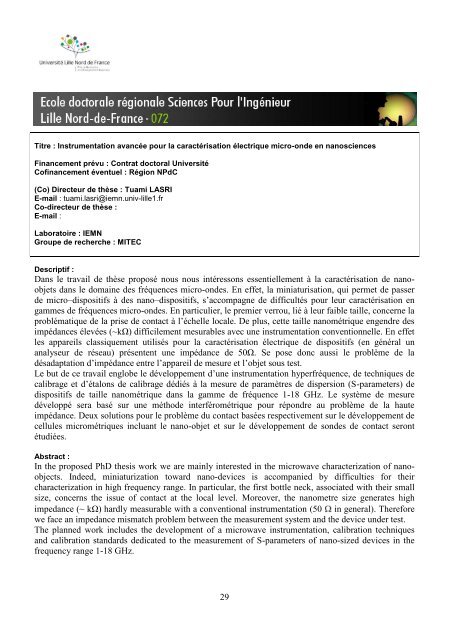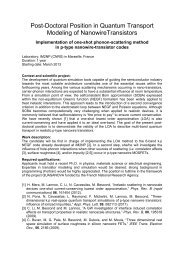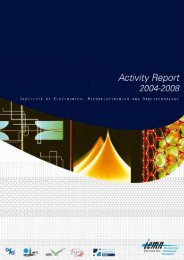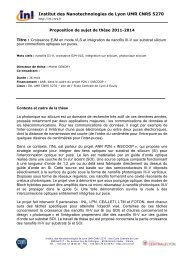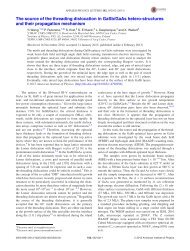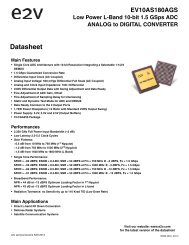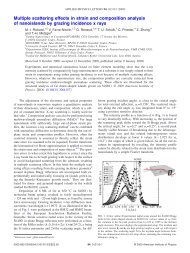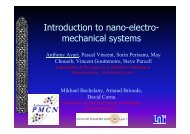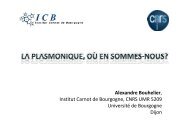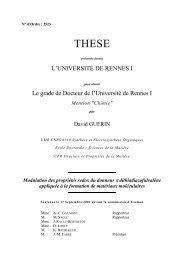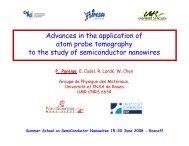Sujet de Doctorats 2013 - IEMN
Sujet de Doctorats 2013 - IEMN
Sujet de Doctorats 2013 - IEMN
- No tags were found...
You also want an ePaper? Increase the reach of your titles
YUMPU automatically turns print PDFs into web optimized ePapers that Google loves.
Titre : Instrumentation avancée pour la caractérisation électrique micro-on<strong>de</strong> en nanosciencesFinancement prévu : Contrat doctoral UniversitéCofinancement éventuel : Région NPdC(Co) Directeur <strong>de</strong> thèse : Tuami LASRIE-mail : tuami.lasri@iemn.univ-lille1.frCo-directeur <strong>de</strong> thèse :E-mail :Laboratoire : <strong>IEMN</strong>Groupe <strong>de</strong> recherche : MITECDescriptif :Dans le travail <strong>de</strong> thèse proposé nous nous intéressons essentiellement à la caractérisation <strong>de</strong> nanoobjetsdans le domaine <strong>de</strong>s fréquences micro-on<strong>de</strong>s. En effet, la miniaturisation, qui permet <strong>de</strong> passer<strong>de</strong> micro–dispositifs à <strong>de</strong>s nano–dispositifs, s’accompagne <strong>de</strong> difficultés pour leur caractérisation engammes <strong>de</strong> fréquences micro-on<strong>de</strong>s. En particulier, le premier verrou, lié à leur faible taille, concerne laproblématique <strong>de</strong> la prise <strong>de</strong> contact à l’échelle locale. De plus, cette taille nanométrique engendre <strong>de</strong>simpédances élevées (~kΩ) difficilement mesurables avec une instrumentation conventionnelle. En effetles appareils classiquement utilisés pour la caractérisation électrique <strong>de</strong> dispositifs (en général unanalyseur <strong>de</strong> réseau) présentent une impédance <strong>de</strong> 50Ω. Se pose donc aussi le problème <strong>de</strong> ladésadaptation d’impédance entre l’appareil <strong>de</strong> mesure et l’objet sous test.Le but <strong>de</strong> ce travail englobe le développement d’une instrumentation hyperfréquence, <strong>de</strong> techniques <strong>de</strong>calibrage et d’étalons <strong>de</strong> calibrage dédiés à la mesure <strong>de</strong> paramètres <strong>de</strong> dispersion (S-parameters) <strong>de</strong>dispositifs <strong>de</strong> taille nanométrique dans la gamme <strong>de</strong> fréquence 1-18 GHz. Le système <strong>de</strong> mesuredéveloppé sera basé sur une métho<strong>de</strong> interférométrique pour répondre au problème <strong>de</strong> la hauteimpédance. Deux solutions pour le problème du contact basées respectivement sur le développement <strong>de</strong>cellules micrométriques incluant le nano-objet et sur le développement <strong>de</strong> son<strong>de</strong>s <strong>de</strong> contact serontétudiées.Abstract :In the proposed PhD thesis work we are mainly interested in the microwave characterization of nanoobjects.In<strong>de</strong>ed, miniaturization toward nano-<strong>de</strong>vices is accompanied by difficulties for theircharacterization in high frequency range. In particular, the first bottle neck, associated with their smallsize, concerns the issue of contact at the local level. Moreover, the nanometre size generates highimpedance (~ kΩ) hardly measurable with a conventional instrumentation (50 in general). Thereforewe face an impedance mismatch problem between the measurement system and the <strong>de</strong>vice un<strong>de</strong>r test.The planned work inclu<strong>de</strong>s the <strong>de</strong>velopment of a microwave instrumentation, calibration techniquesand calibration standards <strong>de</strong>dicated to the measurement of S-parameters of nano-sized <strong>de</strong>vices in thefrequency range 1-18 GHz.29


